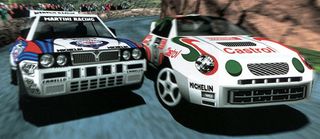The classic game appreciation section: Sega Rally
Officially awesome since 1995
You may find it hard to believe, but before Rez, Child of Eden and Space Channel 5, Tetsuya Mizuguchi made a straight-faced arcade racing game. Looking at it now, it's hard, if not impossible, to see any of his trademark idiosyncrasies in it. The music isn't linked to the action, the cars are as close to photorealistic as possible… it's nothing like his recent work. Ah, but one trademark remains – sheer, genre-smashing brilliance. Let me tell you about the wonder that is Sega Rally.
In 1995, there were only a handful of major racing games in the arcades. Sega's own Virtua Racing had kick-started the rush to make realistic racers, followed by the texture-mapped Daytona USA and Namco's Ridge Racer. But if the latter two games set the benchmark for the arcade generation that followed, Sega Rally represents the pinnacle.

Above: Sega Rally's stars - the Lancia Delta and Toyota Celica, immortalised forever in this landmark racer
Who taught you how to drive?
The game's greatest achievement is its physics engine. You could argue it's too slidey and that everyone crashes the first time they attempt to navigate that right-hander by the zebra because the car's movement over loose gravel is exaggerated slightly. But this is an arcade game – as with Daytona, Ridge Racer and OutRun 2, the car handling has been exaggerated deliberately to make it fun, although Sega Rally keeps its roots in the real world way more than any other arcade racer I can think of.
You can lose control of the car simply by putting two wheels on a bump and turning away from it. The gravity and inertia here is exemplary. Let go of the controls on a hill and the car will roll down it until it hits an incline, whereupon it will slow to a halt and then start rolling back the other way. It's possible to spin the car with too much welly under acceleration and there's no such thing as the 'perfect' line. The track surface undulates so subtly, there's always a new option to try.
For instance, there's thethree days I spent practicing on the Desert track for the World Record run a couple of years ago. Even after over a decade playing the game and all this ultra-concentrated practice, I still feel like I'm only just learning the track. I only feel like I've scratched the surface of what's possible on it.
But, as with all of Sega's classic coin-ops, this depth that lasts decades is just a bonus that comes way after you get over the initial, unforgettable thrill of just playing the thing. When I sat down at an arcade cabinet in the Hollywood Bowl, Taunton, in 1995, I just couldn't believe my eyes. Perhaps the impact wasn't as great as the first time I played Virtua Racing, but in terms of excitement, it's right up there. Mizuguchi and his team took the Model 2 technology, wrung it for every drop of power it had and then created something supremely playable. This is a game design masterclass.
Sign up to the 12DOVE Newsletter
Weekly digests, tales from the communities you love, and more
Track and feel
The track design is ludicrously good. There's every kind of corner in the game, except perhaps for dramatically cambered banked curves. Let's look at the first track again:

Above: 'Zebra corner' (left) is harder than it looks before you hit the drift-tastic right-hander in the mud
The first two turns are deliberately shallow and wide, to allow you time to get used to steering in this 3D space. As I mentioned, the first challenging corner has that 3D, animated zebra for you to ogle when you inevitably crash into the wall by him. After the next turn, you're presented with three jumps in close succession, each one leaving your car slightly more off-balance, leaving you feeling like you're teetering on the edge of control.

Above: The jumps may look tame in terms of height, but thebrief moments of traction are superbly weighted
After that, it's a drive through a dark, leafy wooded section, splashing through puddles and navigating a flat-out chicane - the close walls giving a superb sensation of speed. But then you emerge into a wide open space, where zebra and a 3D, animated elephant roam. The contrast is superb. You then drift around a long, wide corner – sufficiently shallow to allow gamers to fly through it with the accelerator flat on the floor, but just tight enough to make it the time attack lover's best and worst friend.

Above:This niche is carved into the apex about two-thirds round. Can you find the line to hit it?
As you power out of it and towards the finish line, a helicopter swoops down low overhead, kicking up so much pixelly dust you can barely see the track in front of you. And then "Fiiiiiiiiiiii...nish nish nish!" it's all over. Packing so many moments into a 55-ish second experience is no mean feat, yet it's seamless in its execution. Ridge Racer's seaside drive is comparable, certainly, but that's just one track. Rally packs this much noteworthy content into each of its four tracks.
Justin was a GamesRadar staffer for 10 years but is now a freelancer, musician and videographer. He's big on retro, Sega and racing games (especially retro Sega racing games) and currently also writes for Play Magazine, Traxion.gg, PC Gamer and TopTenReviews, as well as running his own YouTube channel. Having learned to love all platforms equally after Sega left the hardware industry (sniff), his favourite games include Christmas NiGHTS into Dreams, Zelda BotW, Sea of Thieves, Sega Rally Championship and Treasure Island Dizzy.
Most Popular



